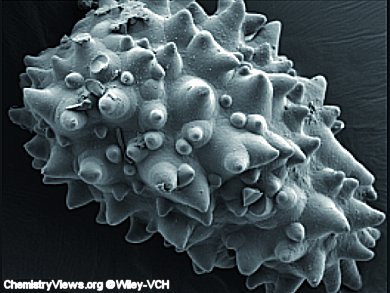Plant cystoliths are mineralized objects that are mainly composed of amorphous calcium carbonate (ACC) and are found in several flowering plants. Cystoliths are formed by specialized cells in the leaf epidermis and function as internal light scatterers that distribute the light flux more evenly inside the leaf.
The initial stalk-like protrusion that connects the cystolith to the outer cell wall is mineralized with silica. The silica stalk is a conserved feature of cystoliths, yet its function is unknown.
Lia Addadi, Weizmann Institute of Sciences, Israel, and colleagues studied the composition and stability of the mineral phases of plant cystoliths.
They show that the silica stalk is formed first and is essential for ACC formation. The cystolith is shown to be composed of four distinct mineral phases with different chemical properties: an almost pure silica phase grades into a Mg-rich silica phase. This Mg-rich silica creates a continuous biocomposite with a relatively stable ACC phase. It is the filler material that determines the final shape and volume of the cystolith. A bulky and less stable ACC phase encapsulates the first ACC phase.
This architecture poses interesting questions about the role of Mg in the silica phase and suggests a strategy for ACC stabilization that takes advantage of a precise regulation of the mineral-growth microenvironment.
- Plant Cystoliths: A Complex Functional Biocomposite of Four Distinct Silica and Amorphous Calcium Carbonate Phases,
Assaf Gal, Anna Hirsch, Stefan Siegel, Chenghao Li, Barbara Aichmayer, Yael Politi, Peter Fratzl, Steve Weiner, Lia Addadi,
Chem. Eur. J. 2012, 18, 10262–10270.
DOI: 10.1002/chem.201201111 - Presented at the 4th EuCheMS Chemistry Congress, Prague
Chemistry—A European Journal invited various speakers of the Congress to contribute an article to their special issue of the conference.




